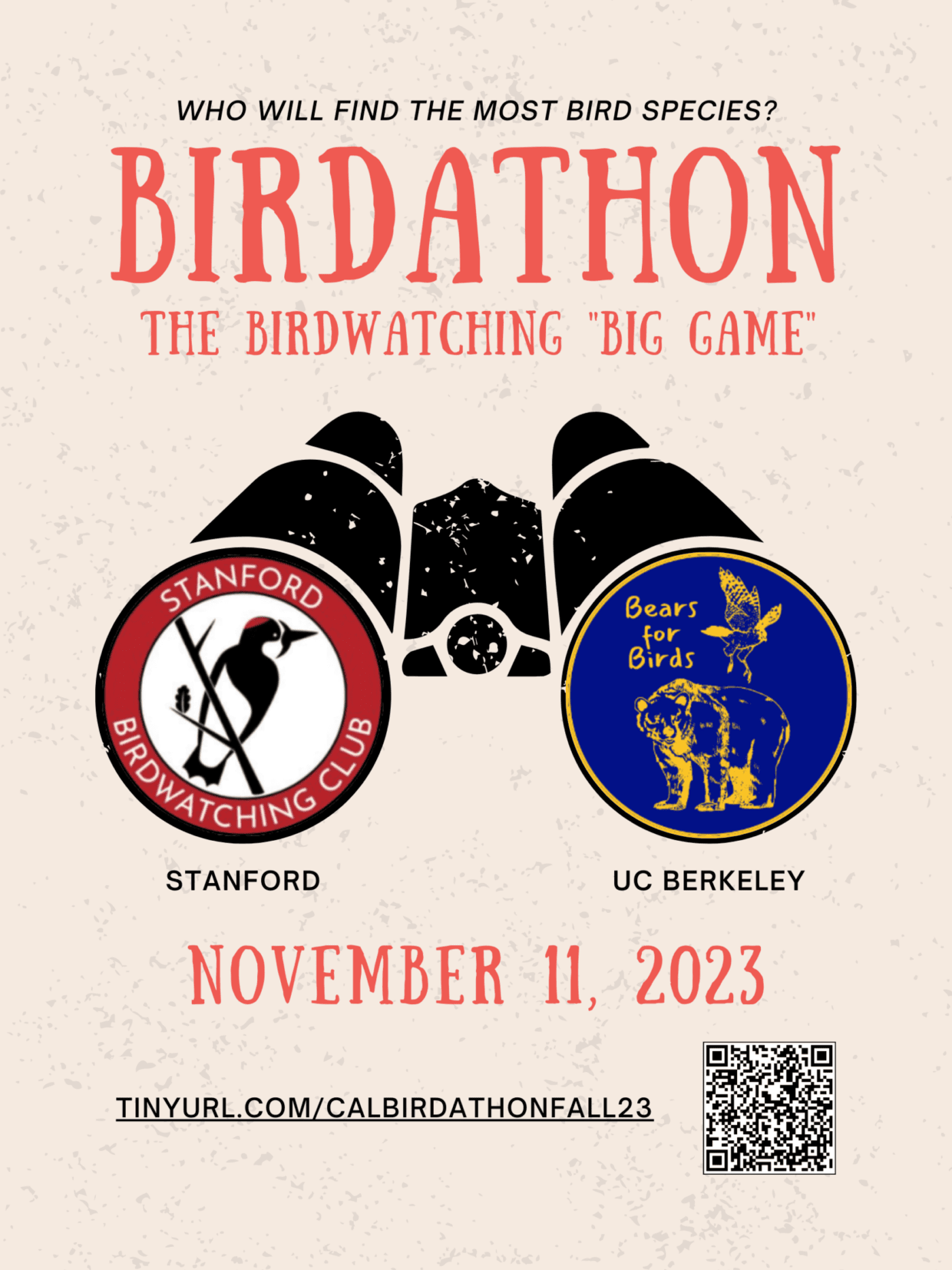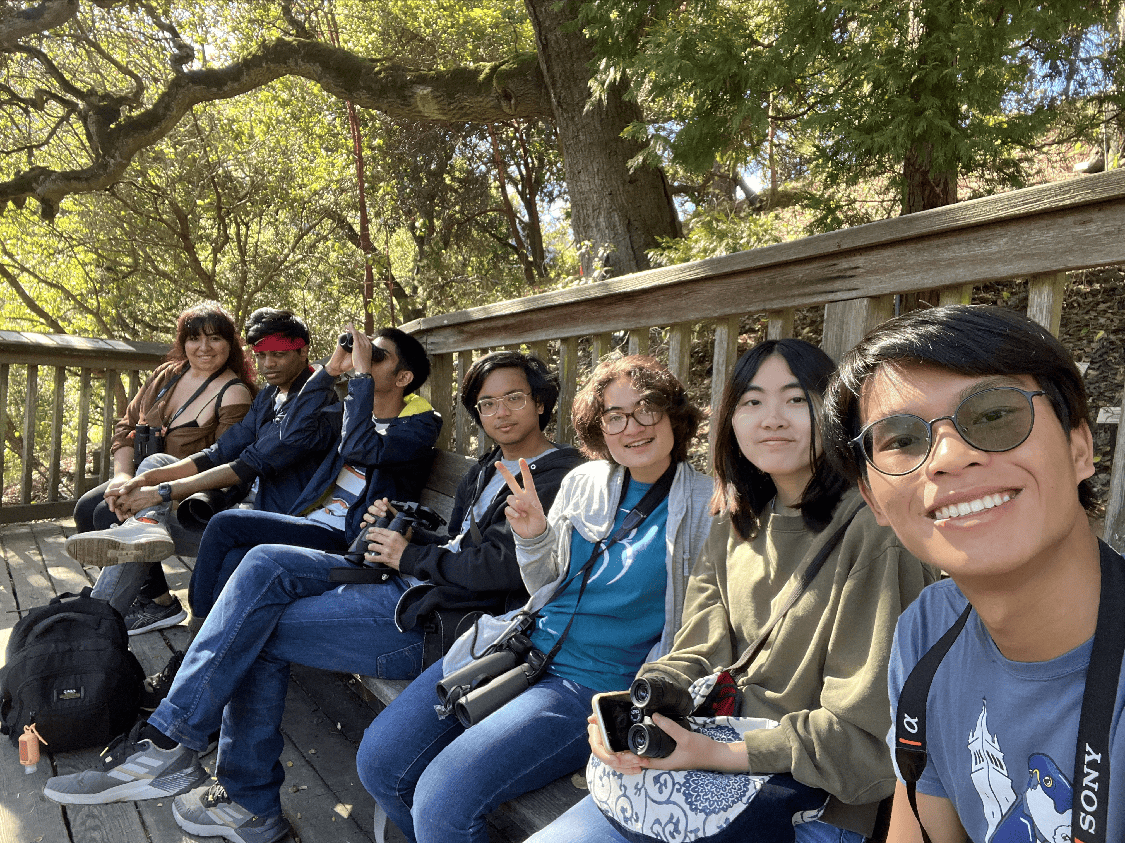Who Won the Fall Big Game?
Results of the Berkeley-Stanford Fall Birdathon are Out!
By Sierra Glassman and Shrey Chaudhary
A flash of feathered flame caught my eye. A scruffy male Western Tanager perched at the crown of a tree in the UC Berkeley Botanical Garden, an exciting moment for the Bears for Birds morning shift during our faceoff with the Stanford Birdwatching Club.
In the spring, our undergraduate student Audubon Campus Chapter at UC Berkeley, Bears for Birds, went head-to-head against the Stanford Birdwatching Club to see which team could observe the most bird species on and around our respective campuses. While we lost in spring,both teams agreed to shift the rules to account for inherent differences between birding locations.
Adam Crawford Burnett, president of the Stanford Birdwatching Club, proposed a different scoring system for this Fall game. This semester, there were two avenues to gain points: whichever team saw the most species above their baseline, an average of the Spring 2023 and Spring 2014 species counts, and whichever team saw the most overall species. Thus, a tie was possible.

Once again, our officer Emily Banno made some wonderful graphics and flyers so we could advertise the Big Game to fellow Bears over social media and on campus.
On the Big Day, November 11, our first excursion was led by Shrey Chaudhary, who had spotted several Killdeer on the small field behind the Hearst Annex a few days earlier. At 5:30am, our small party scouted the dark field to no avail, but we did find a restless Bewick’s Wren hopping about a tree next to the lit Music Library and a Hermit Thrush already beginning to forage in an oak tree. By the Campanile, as the sky lightened, we spotted a flock of twittering Chestnut-backed Chickadees. We walked further east on campus, hearing a Spotted Towhee at Bowles Hall. At the Memorial Stadium, we heard a flock of Golden-crowned Sparrows. Among this flock there were two White-throated Sparrows. By the Foothill Dining Hall were several Acorn Woodpeckers.

Our next excursion was a point count for Bears For Bird’s Berkeley Avian Biodiversity Survey (BABS). These surveys involve standing at each point along one of three possible routes through campus for 10 minutes. As there are six points per route, the count lasts a little over an hour. From 7:30-9am, our group saw a Peregrine Falcon on the Campanile, many Pine Siskins, and heard several woodpecker species. On campus, it is never quiet, even in the morning. Buildings hum, belch steam, and as the sun rises, people come. But among the bustle of campus, there is solace in seeing how birds are still coming to forage in the trees and live alongside us. At our last point, we saw many species coming to bathe in Strawberry Creek: Yellow-rumped Warblers, Red-breasted Nuthatches, another White-throated Sparrow, and more.

Our third excursion of the day was to the UC Berkeley Botanical Gardens at 10am. As we approached the memorial stadium again, we remembered it was a game day, as the roar of the crowd started and barricades were up. The seven of us navigated around the barricade and headed up Canyon Road to the Jordan Trails. At the gardens we heard the rasping calls of Steller’s Jays while two Turkey Vultures flew low over our heads. An amazing sighting was a Western Tanager, rare at this time of the year. After we got back to campus, some of us got lunch at the Foothill Dining Hall.

A large group initially formed for our afternoon point count. A family, the first non-college-student participants also came along; they had seen our flyers around campus. Birding was slow on campus, likely due to the influx of visitors to the game. We saw a Nuttall’s Woodpecker near the Valley Life Science Building, a Brown Creeper, and a Red-tailed Hawk soaring overhead. Some of us split off to bird the botanical gardens again.
At dusk, our owling party headed onto the Clark Kerr fire trails. We walked up to the ridge and as we reached the top, we saw that a clear sky was full of stars, twinkling above the bright city lights. The marching band was still playing. When we got closer to Clark Kerr, we saw a couple deer. After some waiting, we were able to hear the hoots of a Great-horned Owl.
Throughout the day, in addition to officer-led walks, some members birded independently or in their own organized groups, like our second botanical garden party. Our members who birded independently contributed species like White-throated Swifts, Pygmy Nuthatch, Great-horned Owl, and Wild Turkeys from the campus and the fire trails. On his way back home from owling, Shrey went back to the field behind the Hearst Annex, and added Killdeers to our list.
On Sunday, Stanford informed us they got 86 species, which was slightly above their 2014/2023 spring average. The Bears totaled 48 species which was below the average for our 2014/2023 springs. The Stanford Birdwatching Club won both the above-baseline and total species count metrics, crowning them the winner of the Fall 2023 Birdathon! While the Bears didn’t win, we saw some amazing birds and had a lot of fun. View our species list here and Stanford’s trip report here!
We intend to have a go at Stanford again next semester. Since we established a fall baseline species count, perhaps we will rely on it for comparison for future fall games instead of comparing baselines across seasons. This October, Emily Banno and Sierra Glassman spoke with other UC leaders about a potential system-wide Birdathon. So, we may also have some more shifts coming with the potential addition of more universities to our Birdathon this spring…
